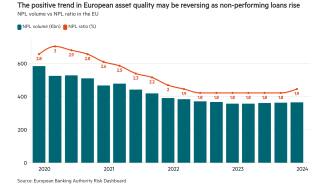Iccrea Banca, which comprises Italian credit unions and rural savings banks, tops 2023’s performance table among the 10 largest Italian lenders. Iccrea has placed first in three categories – asset quality, profitability and return on risk – and has come second for liquidity, soundness and leverage. (The bank did not feature in 2022’s Top 1000 World Banks ranking and performance rankings because it failed to publish its annual results in time.)
According to Fitch Ratings, which upgraded Iccrea in February, the bank saw “significant improvement in asset quality and capital encumbrance from unreserved impaired loans due to the accelerated execution in the bank’s de-risking strategy”.
This year’s performance rankings also saw large Italian banks – UniCredit, Banca Popolare dell'Emilia Romagna (BPER Banca), Intesa Sanpaolo and BancoPosta – improve their positions. For example, UniCredit climbed up from fifth in the country last year to second this year, outdoing its peers in operational efficiency. The country’s largest bank by Tier 1 capital saw its pre-tax profits jump by 450%, to reach $7.76bn, the highest percentage increase among its domestic peers.
BPER Banca, which is the seventh-largest bank in the country, moved up from eighth to third place in the overall performance ranking. Intesa Sanpaolo, the country’s second-largest lender, improved its positioning from ninth to sixth; and BancoPosta, which ranks ninth in the country table by Tier 1, moved up from 10th to fourth spot in the best-performing table. The latter ranked first for liquidity among this year’s cohort.
The biggest fallers in the performance table were Credit Emiliano, which fell from third to ninth place; Banca Monte dei Paschi de Siena (BMPS), which fell from sixth to 10th; Banca Popolare di Sondrio, which went from fourth to eighth; and Mediobanca, which was second in last year’s rankings but only finished fifth this year.
Longsuffering lender BMPS managed to boost its Tier 1 capital by 18.76% in 2022, to $8.09bn; however, its asset base fell 18.4% and it recorded a loss of $672m.
Multichannel lender, Fineco, recorded the highest return on capital ratio, of 28.81%, and the third highest return on assets (1.18%) of the local banks, behind Banca Generali (1.23%) and challenger bank Illimity (1.19%).
One thing that could weigh heavily on Italian banks’ financial performance in the coming months is a proposal to introduce a windfall tax on banks’ profits. According to investment bank Jefferies, there are continued talks on a potential bank tax in Italy. Jefferies estimates that if the tax follows the same design as Spain’s, it could result in a hit of 10% on 2023 net profits for the Italian banks affected.










